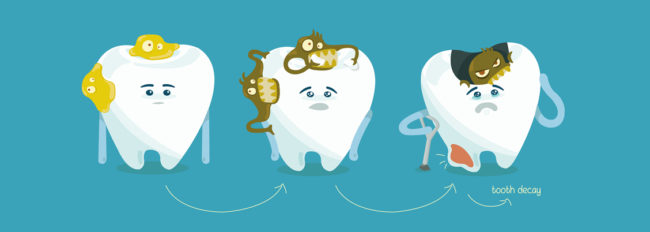Sugar-laden candy bars aren’t the only cause of cavities. Tooth decay actually results when bacteria in your mouth feed on food debris (starchy, sticky foods are a primary culprit) and produce acid as a by-product. This mix of food, acid, saliva, and germs clings to your teeth as a filmy substance called plaque, which can erode teeth enamel and cause cavities to form.
These germs can spread from mouth to mouth via shared food and utensils, sneezing, kissing, and more.
Despite your mother’s finger-wagging, sugar-laden candy bars aren’t the only cause of cavities. Tooth decay actually results when bacteria in your mouth feed on food debris (starchy, sticky foods are a primary culprit) and produce acid as a by-product. This mix of food, acid, saliva, and germs clings to your teeth as a filmy substance called plaque, which can erode teeth enamel and cause cavities to form.
No matter what you eat, cavities won’t form without the help of such bacteria. These germs can spread from mouth to mouth via shared food and utensils, sneezing, kissing, and more, according to Edward “Trey” Wilson, DDS, a dentist in private practice in New York City and New Hope, Pa. — making cavities contagious.
One study in the Australian Dental Journal pegged tooth decay as one of the most common infectious oral diseases. Researchers found that 30 percent of 3-month-olds, 60 percent of 6-month-olds, and nearly 80 percent of 2-year-olds were infected with cavity-causing Streptococcus mutans bacteria, a strain that’s especially likely to cause cavities.
Researchers believe that children “caught” the germs from their mothers; those with a history of cavities were more likely to pass the bacteria along to their children.
So does this mean you should avoid smooching with someone who has a horrible track record at the dentist? Not for dental health reasons, at least: As an adult, you’re far less susceptible to bacteria spread than children because they haven’t built up immunity yet.
Here are tips for preventing cavity spread in your family:
- Go to the dentist. Nearly half of adults skipped the dentist in 2009, according to the U.S. Centers for Disease Control and Prevention (CDC). But to keep from passing on a cavity, your first step should be to schedule a dental check-up. “Every adult needs to be screened for tooth decay,” says Wilson. While warning signs such as tooth sensitivity, pain, or visible holes in teeth are cavity clues, one of the biggest mistakes patients make is to avoid the dentist until they’re in pain. Regular cleanings (every six months) can help prevent decay from turning into cavities and reduce levels of cavity-causing (and cavity-spreading) bacteria in your mouth. According to CDC data, 23 percent of adults have untreated cavities.
- Use a heavy-duty mouth rinse. If a cavity has formed, you’ll need a filling. But for early-stage decay, your dentist can prescribe mouth rinse with chlorhexidine, a powerful antiseptic that fights off bacteria and can prevent decay from developing into cavities.
- Chew sugar-free gum between meals. Pick a brand with the artificial sweetener xylitol, and chew it three times a day for at least five minutes, Xylitol boosts saliva production, which helps fight off bad bacteria.
- Don’t overshare. If you have young kids, avoid sharing utensils with them or tasting food before serving it to them. Cover your mouth when you sneeze, and if you’re really concerned, “maybe kiss your kid on the cheek instead of the lips,”
- Be a good dental patient. This time, heed the hygienist’s advice: Brush frequently (in the morning, at night, and after meals), floss daily, and put a cap on sugary drinks and snacks — and instill the same tooth-friendly habits in your kids. With infants, clean your baby’s teeth with a soft cloth or gauze pad as soon as they start to come in; you can switch to a soft toothbrush when more teeth emerge.
- Forgo fancy water. You may also want to consider switching your family from bottled water to tap. Most tap water contains fluoride, which helps teeth build up resistance to plaque.

